Hypothesis Of Mean Value Theorem
4.three: The Mean Value Theorem
- Page ID
- 72015
Learning Objectives
- Explain the meaning of Rolle's theorem.
- Describe the significance of the Hateful Value Theorem.
- State three important consequences of the Mean Value Theorem.
The Hateful Value Theorem is one of the well-nigh important theorems in calculus. We look at some of its implications at the end of this section. First, let's start with a special case of the Mean Value Theorem, called Rolle'due south theorem.
Rolle'south Theorem
Informally, Rolle's theorem states that if the outputs of a differentiable role \(f\) are equal at the endpoints of an interval, then there must be an interior point \(c\) where \(f'(c)=0\). Figure \(\PageIndex{1}\) illustrates this theorem.
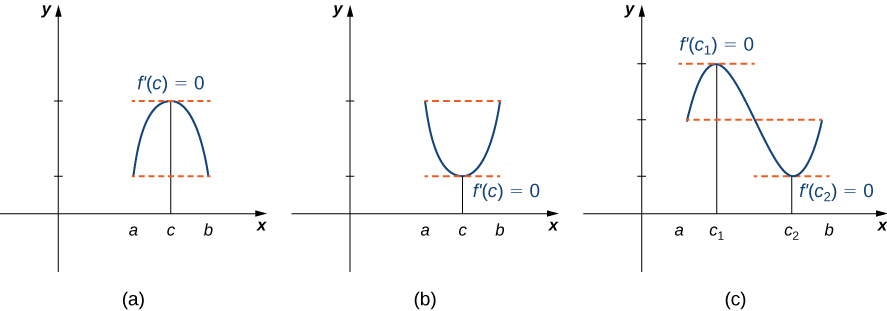
Rolle'south Theorem
Let \(f\) exist a continuous function over the closed interval \([a,b]\) and differentiable over the open up interval \((a,b)\) such that \(f(a)=f(b)\). There then exists at least one \(c∈(a,b)\) such that \(f'(c)=0.\)
Proof
Let \(g=f(a)=f(b).\) We consider three cases:
- \(f(10)=k\) for all \(10∈(a,b).\)
- There exists \(x∈(a,b)\) such that \(f(10)>1000.\)
- There exists \(x∈(a,b)\) such that \(f(x)<thousand.\)
Instance one: If \(f(x)=k\) for all \(x∈(a,b)\), and then \(f'(10)=0\) for all \(x∈(a,b).\)
Case two: Since \(f\) is a continuous part over the airtight, bounded interval \([a,b]\), by the extreme value theorem, it has an absolute maximum. As well, since there is a bespeak \(10∈(a,b)\) such that \(f(x)>g\), the accented maximum is greater than \(k\). Therefore, the absolute maximum does non occur at either endpoint. Every bit a result, the absolute maximum must occur at an interior indicate \(c∈(a,b)\). Because \(f\) has a maximum at an interior bespeak \(c\), and \(f\) is differentiable at \(c\), past Fermat's theorem, \(f'(c)=0.\)
Case 3: The case when there exists a point \(x∈(a,b)\) such that \(f(x)<1000\) is analogous to instance 2, with maximum replaced by minimum.
□
An important point well-nigh Rolle'southward theorem is that the differentiability of the office \(f\) is critical. If \(f\) is non differentiable, even at a single point, the result may not hold. For example, the role \(f(ten)=|10|−i\) is continuous over \([−1,1]\) and \(f(−1)=0=f(1)\), but \(f'(c)≠0\) for any \(c∈(−1,i)\) as shown in the following figure.
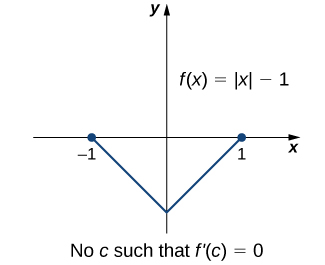
Let's now consider functions that satisfy the weather condition of Rolle's theorem and calculate explicitly the points \(c\) where \(f'(c)=0.\)
Example \(\PageIndex{1}\): Using Rolle'south Theorem
For each of the following functions, verify that the part satisfies the criteria stated in Rolle'due south theorem and find all values \(c\) in the given interval where \(f'(c)=0.\)
- \(f(10)=x^2+2x\) over \([−2,0]\)
- \(f(x)=10^3−4x\) over \([−2,2]\)
Solution
a. Since \(f\) is a polynomial, it is continuous and differentiable everywhere. In addition, \(f(−2)=0=f(0).\) Therefore, \(f\) satisfies the criteria of Rolle'southward theorem. We conclude that in that location exists at to the lowest degree ane value \(c∈(−2,0)\) such that \(f'(c)=0\). Since \(f'(x)=2x+2=2(x+1),\) we come across that \(f'(c)=2(c+1)=0\) implies \(c=−one\) as shown in the following graph.

b. As in role a. \(f\) is a polynomial and therefore is continuous and differentiable everywhere. Also, \(f(−2)=0=f(ii).\) That said, \(f\) satisfies the criteria of Rolle's theorem. Differentiating, we find that \(f'(x)=3x^2−iv.\) Therefore, \(f'(c)=0\) when \(10=±\frac{2}{\sqrt{3}}\). Both points are in the interval \([−ii,ii]\), and, therefore, both points satisfy the decision of Rolle's theorem every bit shown in the following graph.

Practise \(\PageIndex{i}\)
Verify that the function \(f(x)=2x^ii−8x+6\) divers over the interval \([1,three]\) satisfies the conditions of Rolle'due south theorem. Find all points \(c\) guaranteed by Rolle'southward theorem.
- Hint
-
Find all values \(c\), where \(f'(c)=0\).
- Answer
-
\(c=ii\)
The Mean Value Theorem and Its Meaning
Rolle's theorem is a special instance of the Mean Value Theorem. In Rolle's theorem, we consider differentiable functions \(f\) that are null at the endpoints. The Mean Value Theorem generalizes Rolle's theorem past because functions that are not necessarily nothing at the endpoints. Consequently, we can view the Mean Value Theorem as a slanted version of Rolle's theorem (Effigy \(\PageIndex{5}\)). The Mean Value Theorem states that if \(f\) is continuous over the closed interval \([a,b]\) and differentiable over the open up interval \((a,b)\), then there exists a betoken \(c∈(a,b)\) such that the tangent line to the graph of \(f\) at \(c\) is parallel to the secant line connecting \((a,f(a))\) and \((b,f(b)).\)
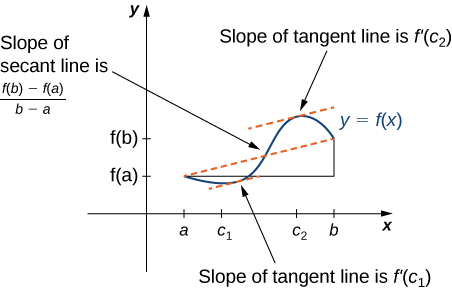
Mean Value Theorem
Let \(f\) be continuous over the airtight interval \([a,b]\) and differentiable over the open interval \((a,b)\). Then, in that location exists at to the lowest degree 1 point \(c∈(a,b)\) such that
\[f'(c)=\frac{f(b)−f(a)}{b−a} \nonumber \]
Proof
The proof follows from Rolle'south theorem past introducing an appropriate function that satisfies the criteria of Rolle'southward theorem. Consider the line connecting \((a,f(a))\) and \((b,f(b)).\) Since the gradient of that line is
\[\frac{f(b)−f(a)}{b−a} \nonumber \]
and the line passes through the signal \((a,f(a)),\) the equation of that line tin be written as
\[y=\frac{f(b)−f(a)}{b−a}(ten−a)+f(a). \nonumber \]
Allow \(g(x)\) announce the vertical deviation between the bespeak \((x,f(x))\) and the betoken \((10,y)\) on that line. Therefore,
\[g(x)=f(x)−\left[\frac{f(b)−f(a)}{b−a}(x−a)+f(a)\right]. \nonumber \]
 Effigy \(\PageIndex{six}\): The value \(g(ten)\) is the vertical difference betwixt the signal \((x,f(x))\) and the point \((x,y)\) on the secant line connecting \((a,f(a))\) and \((b,f(b))\).
Effigy \(\PageIndex{six}\): The value \(g(ten)\) is the vertical difference betwixt the signal \((x,f(x))\) and the point \((x,y)\) on the secant line connecting \((a,f(a))\) and \((b,f(b))\).Since the graph of \(f\) intersects the secant line when \(x=a\) and \(x=b\), nosotros come across that \(thousand(a)=0=g(b)\). Since \(f\) is a differentiable office over \((a,b)\), \(grand\) is also a differentiable function over \((a,b)\). Furthermore, since \(f\) is continuous over \([a,b], \, g\) is also continuous over \([a,b]\). Therefore, \(g\) satisfies the criteria of Rolle's theorem. Consequently, there exists a betoken \(c∈(a,b)\) such that \(g'(c)=0.\) Since
\[g'(ten)=f'(x)−\frac{f(b)−f(a)}{b−a}, \nonumber \]
we see that
\[g'(c)=f'(c)−\frac{f(b)−f(a)}{b−a}. \nonumber \]
Since \(m'(c)=0,\) we conclude that
\[f'(c)=\frac{f(b)−f(a)}{b−a}. \nonumber \]
□
In the next example, nosotros show how the Hateful Value Theorem can be applied to the office \(f(ten)=\sqrt{x}\) over the interval \([0,9]\). The method is the same for other functions, although sometimes with more interesting consequences.
Instance \(\PageIndex{2}\): Verifying that the Hateful Value Theorem Applies
For \(f(x)=\sqrt{x}\) over the interval \([0,9]\), show that \(f\) satisfies the hypothesis of the Mean Value Theorem, and therefore there exists at to the lowest degree one value \(c∈(0,ix)\) such that \(f′(c)\) is equal to the slope of the line connecting \((0,f(0))\) and \((9,f(9))\). Find these values \(c\) guaranteed by the Mean Value Theorem.
Solution
We know that \(f(10)=\sqrt{ten}\) is continuous over \([0,nine]\) and differentiable over \((0,9).\) Therefore, \(f\) satisfies the hypotheses of the Hateful Value Theorem, and there must be at least one value \(c∈(0,9)\) such that \(f′(c)\) is equal to the slope of the line connecting \((0,f(0))\) and \((9,f(9))\) (Figure \(\PageIndex{vii}\)). To determine which value(s) of \(c\) are guaranteed, outset calculate the derivative of \(f\). The derivative \(f′(x)=\frac{i}{(ii\sqrt{x})}\). The slope of the line connecting \((0,f(0))\) and \((ix,f(9))\) is given by
\[\frac{f(9)−f(0)}{9−0}=\frac{\sqrt{9}−\sqrt{0}}{9−0}=\frac{3}{9}=\frac{i}{iii}. \nonumber \]
Nosotros want to find \(c\) such that \(f′(c)=\frac{1}{3}\). That is, we want to notice \(c\) such that
\[\frac{ane}{2\sqrt{c}}=\frac{1}{three}. \nonumber \]
Solving this equation for \(c\), we obtain \(c=\frac{nine}{4}\). At this signal, the slope of the tangent line equals the slope of the line joining the endpoints.
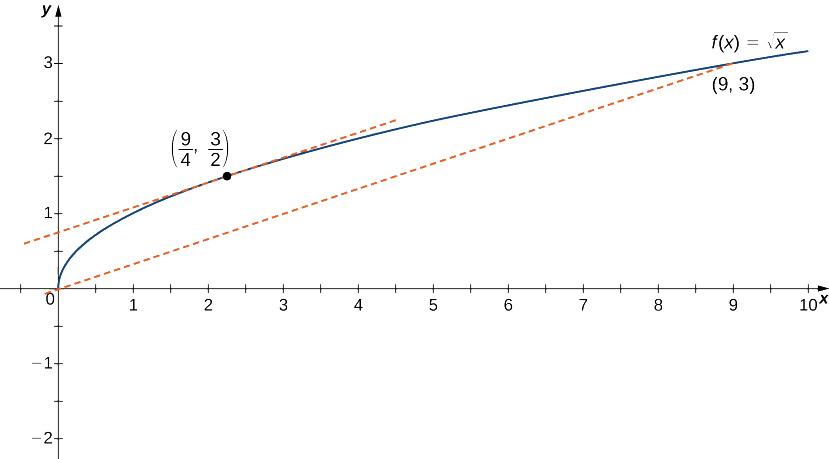
One awarding that helps illustrate the Mean Value Theorem involves velocity. For example, suppose we drive a auto for one h down a straight road with an average velocity of 45 mph. Let \(southward(t)\) and \(v(t)\) denote the position and velocity of the motorcar, respectively, for \(0≤t≤1\) h. Assuming that the position function \(s(t)\) is differentiable, we tin employ the Mean Value Theorem to conclude that, at some time \(c∈(0,1)\), the speed of the car was exactly
\[5(c)=due south′(c)=\frac{s(ane)−s(0)}{1−0}=45\,\text{mph.} \nonumber \]
Case \(\PageIndex{3}\): Mean Value Theorem and Velocity
If a rock is dropped from a height of 100 ft, its position \(t\) seconds after information technology is dropped until it hits the ground is given by the part \(s(t)=−16t^2+100.\)
- Make up one's mind how long it takes before the rock hits the ground.
- Notice the average velocity \(v_{avg}\) of the rock for when the rock is released and the rock hits the basis.
- Find the fourth dimension \(t\) guaranteed by the Mean Value Theorem when the instantaneous velocity of the rock is \(v_{avg}.\)
Solution
a. When the rock hits the ground, its position is \(s(t)=0\). Solving the equation \(−16t^2+100=0\) for \(t\), nosotros find that \(t=±\frac{5}{ii}sec\). Since we are only because \(t≥0\), the brawl will hit the ground \(\frac{v}{2}\) sec after it is dropped.
b. The average velocity is given by
\[v_{avg}=\frac{s(v/2)−s(0)}{five/2−0}=\frac{0−100}{5/ii}=−40\,\text{ft/sec}. \nonumber \]
c. The instantaneous velocity is given by the derivative of the position role. Therefore, we demand to find a time \(t\) such that \(five(t)=s′(t)=v_{avg}=−forty\) ft/sec. Since \(s(t)\) is continuous over the interval \([0,five/2]\) and differentiable over the interval \((0,5/2),\) by the Mean Value Theorem, there is guaranteed to be a point \(c∈(0,v/2)\) such that
\[s′(c)=\frac{s(five/2)−s(0)}{5/2−0}=−forty. \nonumber \]
Taking the derivative of the position part \(due south(t)\), we find that \(southward′(t)=−32t.\) Therefore, the equation reduces to \(s′(c)=−32c=−40.\) Solving this equation for \(c\), nosotros accept \(c=\frac{5}{4}\). Therefore, \(\frac{v}{4}\) sec after the stone is dropped, the instantaneous velocity equals the average velocity of the rock during its free fall: \(−40\) ft/sec.
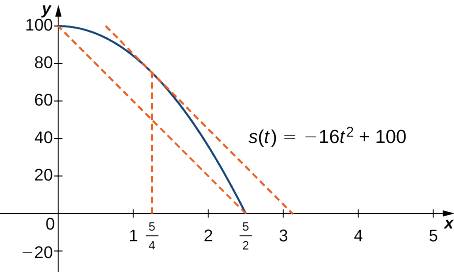
Practice \(\PageIndex{two}\)
Suppose a ball is dropped from a height of 200 ft. Its position at time \(t\) is \(southward(t)=−16t^2+200.\) Find the time \(t\) when the instantaneous velocity of the ball equals its average velocity.
- Hint
-
Offset, determine how long it takes for the ball to hit the ground. Then, notice the average velocity of the ball from the fourth dimension information technology is dropped until information technology hits the basis.
- Answer
-
\(\frac{5}{2\sqrt{ii}}\) sec
Corollaries of the Hateful Value Theorem
Let'southward now look at three corollaries of the Mean Value Theorem. These results have important consequences, which nosotros use in upcoming sections.
At this betoken, we know the derivative of any constant function is nada. The Mean Value Theorem allows us to conclude that the converse is as well true. In particular, if \(f′(x)=0\) for all \(x\) in some interval \(I\), then \(f(x)\) is constant over that interval. This consequence may seem intuitively obvious, only it has important implications that are not obvious, and we discuss them before long.
Corollary 1: Functions with a Derivative of Zero
Let \(f\) exist differentiable over an interval \(I\). If \(f′(x)=0\) for all \(x∈I\), then \(f(x)=\) abiding for all \(x∈I.\)
Proof
Since \(f\) is differentiable over \(I\), \(f\) must be continuous over \(I\). Suppose \(f(10)\) is not constant for all \(10\) in \(I\). And so there exist \(a,b∈I\), where \(a≠b\) and \(f(a)≠f(b).\) Choose the annotation then that \(a<b.\) Therefore,
\[\frac{f(b)−f(a)}{b−a}≠0. \nonumber \]
Since \(f\) is a differentiable function, by the Mean Value Theorem, at that place exists \(c∈(a,b)\) such that
\[f′(c)=\frac{f(b)−f(a)}{b−a}. \nonumber \]
Therefore, there exists \(c∈I\) such that \(f′(c)≠0\), which contradicts the assumption that \(f′(x)=0\) for all \(x∈I\).
□
From "Corollary 1: Functions with a Derivative of Naught," it follows that if 2 functions have the same derivative, they differ past, at most, a constant.
Corollary 2: Abiding Difference Theorem
If \(f\) and \(1000\) are differentiable over an interval \(I\) and \(f′(ten)=one thousand′(x)\) for all \(x∈I\), and so \(f(x)=1000(10)+C\) for some constant \(C\).
Proof
Permit \(h(10)=f(10)−thou(x).\) Then, \(h′(x)=f′(x)−one thousand′(x)=0\) for all \(x∈I.\) By Corollary 1, at that place is a constant \(C\) such that \(h(x)=C\) for all \(x∈I\). Therefore, \(f(x)=g(x)+C\) for all \(x∈I.\)
□
The third corollary of the Mean Value Theorem discusses when a office is increasing and when information technology is decreasing. Recall that a office \(f\) is increasing over \(I\) if \(f(x_1)<f(x_2)\) whenever \(x_1<x_2\), whereas \(f\) is decreasing over \(I\) if \(f(x_1)>f(x_2)\) whenever \(x_1<x_2\). Using the Mean Value Theorem, we can show that if the derivative of a part is positive, then the function is increasing; if the derivative is negative, then the function is decreasing (Figure \(\PageIndex{9}\)). We make use of this fact in the next section, where we evidence how to use the derivative of a function to locate local maximum and minimum values of the part, and how to determine the shape of the graph.
This fact is important considering it means that for a given role \(f\), if at that place exists a part \(F\) such that \(F′(x)=f(x)\); and so, the only other functions that have a derivative equal to \(f\) are \(F(10)+C\) for some abiding \(C\). We discuss this result in more than item later in the chapter.
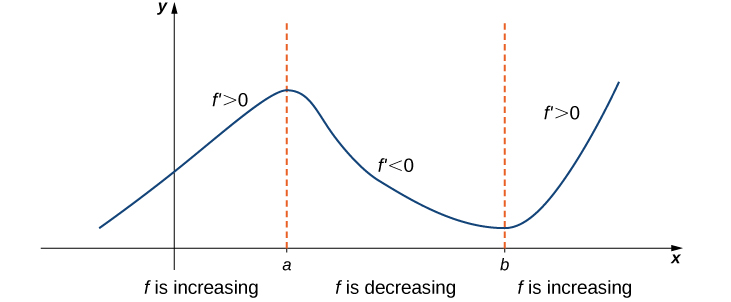
Corollary 3: Increasing and Decreasing Functions
Let \(f\) be continuous over the closed interval \([a,b]\) and differentiable over the open interval \((a,b)\).
- If \(f′(ten)>0\) for all \(ten∈(a,b)\), and so \(f\) is an increasing function over \([a,b].\)
- If \(f′(x)<0\) for all \(x∈(a,b)\), and so \(f\) is a decreasing office over \([a,b].\)
Proof
We will prove i.; the proof of two. is similar. Suppose \(f\) is not an increasing function on \(I\). And then there be \(a\) and \(b\) in \(I\) such that \(a<b\), just \(f(a)≥f(b)\). Since \(f\) is a differentiable function over \(I\), past the Hateful Value Theorem there exists \(c∈(a,b)\) such that
\[f′(c)=\frac{f(b)−f(a)}{b−a}. \nonumber \]
Since \(f(a)≥f(b)\), we know that \(f(b)−f(a)≤0\). Also, \(a<b\) tells us that \(b−a>0.\) We conclude that
\[f′(c)=\frac{f(b)−f(a)}{b−a}≤0. \nonumber \]
However, \(f′(ten)>0\) for all \(x∈I\). This is a contradiction, and therefore \(f\) must be an increasing function over \(I\).
□
Key Concepts
- If \(f\) is continuous over \([a,b]\) and differentiable over \((a,b)\) and \(f(a)=f(b)\), so there exists a point \(c∈(a,b)\) such that \(f′(c)=0.\) This is Rolle's theorem.
- If \(f\) is continuous over \([a,b]\) and differentiable over \((a,b)\), then there exists a point \(c∈(a,b)\) such that \[f'(c)=\frac{f(b)−f(a)}{b−a}. \nonumber \] This is the Mean Value Theorem.
- If \(f'(x)=0\) over an interval \(I\), so \(f\) is constant over \(I\).
- If two differentiable functions \(f\) and \(1000\) satisfy \(f′(10)=grand′(x)\) over \(I\), then \(f(x)=g(10)+C\) for some constant \(C\).
- If \(f′(10)>0\) over an interval \(I\), then \(f\) is increasing over \(I\). If \(f′(x)<0\) over \(I\), so \(f\) is decreasing over \(I\).
Glossary
- hateful value theorem
-
if \(f\) is continuous over \([a,b]\) and differentiable over \((a,b)\), then there exists \(c∈(a,b)\) such that \(f′(c)=\frac{f(b)−f(a)}{b−a}\)
- rolle'southward theorem
- if \(f\) is continuous over \([a,b]\) and differentiable over \((a,b)\), and if \(f(a)=f(b)\), and then there exists \(c∈(a,b)\) such that \(f′(c)=0\)
Hypothesis Of Mean Value Theorem,
Source: https://math.libretexts.org/Courses/Reedley_College/Calculus_I_%28Casteel%29/04:_Applications_of_Derivatives/4.03:_The_Mean_Value_Theorem
Posted by: bullhatuared.blogspot.com


0 Response to "Hypothesis Of Mean Value Theorem"
Post a Comment